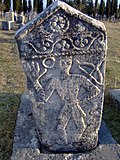Kosor Bridge
- Kosor
- Bosnia and Herzegovina

Stone Bridge in Kosor, or Kosor Bridge, also Danijal Pasha's Bridge, (Bosnian: Kosorska ćuprija), is the former bridge in the settlement of Kosor, in the City (former Municipality) of Mostar, Bosnia and Herzegovina. The bridge spanned the river Buna. On April 3, 2014, it was declared a national monument of Bosnia and Herzegovina.[1]
History and description
The remains of the bridge are located on the Buna River, not far from its confluence with the Neretva, in the area of the Kosor settlement.
In the literature, different data are given about the time of the creation of this bridge. Some believe that the bridging of the Buna near its mouth was created during the time of the Romans.[2]
Others are of the opinion that the bridge was built by Karađoz, who had already built the bridges, such as Karađoz Bridge over the Buna in Blagaj and Stara Ćuprija bridge over the Neretva in Konjic, and many other edifices, such as Karađoz Bey Mosque in Mostar.[1]
For the first time, this bridge was mentioned by the Ottoman travel writer Evliya Çelebi and recorded it under the name Danijal Pasha's Bridge on the Buna. At one time, this was the largest bridge in Herzegovina. In 1945, the Germans demolished it with a explosives during their retreat from the region, and today there is a new concrete bridge in its place.[3]
The total length of the bridge was 57 m, width over 4 m, with abutments connected by thirteen strong stone semicircular arches. The remains of this bridge are inscribed national monument, which consist of the remains of six bridge pillars and an arched structure located on the western (right) bank of the Buna River.[1]
Buna Bridge
Buna Bridge with 14 stone-arches was located less than 2 kilometers downstream from Danijal-pasha's Bridge or Kosorska ćuprija.
- Buna Bridge
-

-

See also
- Stari Most
- Klepci bridge
- List of bridges in Bosnia and Herzegovina
- List of National Monuments of Bosnia and Herzegovina
References
- ^ a b c "The stone bridge on Kosor, the site and remains of a historical building". Commission for the Preservation of National Monuments of Bosnia and Herzegovina. Sarajevo: KONS. April 3, 2014. Retrieved 10 January 2024.
- ^ Mr. sc. Krešimir Šaravanja, dipl. ing. „IGH-MOSTAR“ d.o.o. Mostar, Građevinski fakultet Sveučilišta u Mostaru, ing. Prof. dr. Ivo Čolak, Građevinski fakultet Sveučilišta u Mostaru, -MOSTOVI MOSTARA - OD RIMSKIH MOSTOVA DO STAROG MOSTA.
- ^ "Džemal Ćelić - Mehmed Mujezinović: Stari mostovi u BiH)". Sarajevo publishing 1998, Kulturno naslijeđe. Retrieved 9 Feb 2017.
External links
- Kameni most na Buni
- v
- t
- e
For official site names and detailed information, see each article or the List of National Monuments of Bosnia and Herzegovina.
| Buildings |
|
|---|---|
| Bunkers & underground structures | |
| Bridges |
|
| Clock-towers |
|
| Fountains |

castles,walled cities,
open & market towns
| Royal court | |
|---|---|
| Open & market towns | |
| Walled cities | |
| Castles & citadels |
|
| Odžaci (towers) |
- Vranduk
- Old Town of Mostar
- Blagaj
- Baščaršija
- Počitelj
- Džidžikovac
- Čekaluša street
- Vratnik old walled neighborhood
ensembles
/ Cultural landscape
architectural ensembles
- Old Marijin Dvor power station
- Old Hrid power station
- Small hydro power plant Bihać on Jarak in Bihać (a.k.a. Hydro power plant „Jarak“, or „Canal Una“)
- Koševo chimney
household
and places of worship
| Islamic |
|
|---|---|
| Catholic | |
| Orthodox | |
| Judaic |
|
| Bosnian Church | |
| Other (Temple of Mithras) |
| Illyrians | |
|---|---|
| Roman | |
| Early Christianity |
|
and necropolis
| Memorials |
|
|---|---|
| Cemeteries |
|
| Türbe mausoleums |
|
| Tombs, Crypts & catacombs | |
| Necropolis |
- Sarajevo Haggadah
- Zmijanje embroidery
- Mural Zuke Džumhura
Archives, museums, etc.
- 1 Shared with Croatia, Montenegro, Serbia













